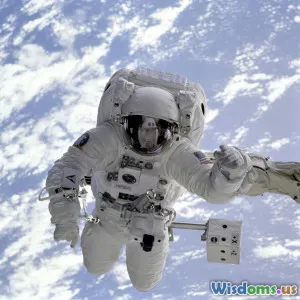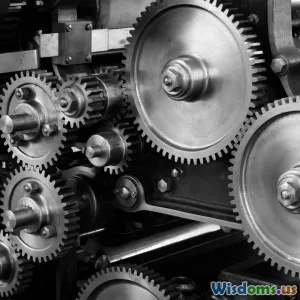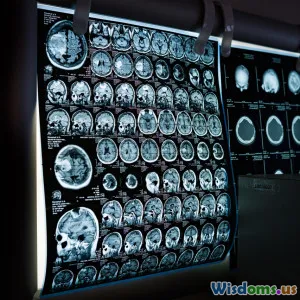
Survive a Year on the ISS The Astronauts Daily Struggles
8 min read Explore the daily challenges astronauts face surviving a year aboard the ISS, from physical health to mental resilience in microgravity. (0 Reviews)
Survive a Year on the ISS: The Astronauts' Daily Struggles
Venturing beyond the comfort of Earth into the void of space is a dream that humanity has pursued for decades. But living on the International Space Station (ISS) for an extended period—especially a full year—introduces a complex series of challenges far beyond what most can imagine. The triumph of floating peacefully amid the stars belies the daily hardships astronauts experience—from managing their physical health in microgravity, coping with psychological stress, to performing complex scientific experiments in cramped quarters. This article dives into the real struggles astronauts face living in space for a year and the strategies they use to survive and thrive.
Life in Microgravity: An Unseen Physical Challenge
One of the most profound hardships of spending extended time aboard the ISS is adapting to microgravity. Earth's gravity anchors us firmly, but in orbit, that force virtually disappears, reshaping bones, muscles, and bodily systems.
Muscle Atrophy and Bone Loss
Without gravity’s constant pull, muscles don’t have to work as hard. Research from NASA has shown astronauts can lose up to 20% of their muscle mass on missions lasting about six months, with some bone density depletion reaching 1–2% per month. This rapid deterioration puts crew members at serious risk for fractures once back on Earth. Astronauts combat this with rigorous daily exercise regimens—two hours a day involving treadmills with harnesses, stationary bikes, and resistance devices designed specifically for microgravity. These routines help maintain muscle strength and stimulate bone health.
Fluid Redistribution and Cardiovascular Effects
In microgravity, bodily fluids shift towards the upper body and head, causing facial puffiness and pressure in the skull. This shift may be part of why many astronauts report vision problems post-flight, a condition known as Spaceflight-Associated Neuro-ocular Syndrome (SANS). NASA investigators are actively studying this phenomenon. Techniques such as lower body negative pressure devices help simulate Earth's gravity to redistribute fluids and mitigate risks.
Sleep and Circadian Rhythms
The ISS orbits Earth approximately every 90 minutes, resulting in multiple sunrises and sunsets daily. This disrupts circadian rhythms, making it difficult to maintain regular sleep patterns. Poor sleep affects cognitive functions and mood. To address this, astronauts follow strict sleep schedules and wear eye masks, while the station uses lighting systems that mimic Earth’s natural light cycles to cue their bodies for rest.
Psychological Struggles: Isolation, Confinement, and Team Dynamics
Living virtually isolated 250 miles above Earth in a pressurized module no larger than a small apartment brings unique psychological stressors.
Coping with Isolation and Confinement
Months away from family and friends amplify feelings of loneliness and detachment. Confined spaces can induce a “cabin fever” effect, where the lack of personal space and monotonous surroundings create mental fatigue. Psychologists compare these conditions to submarine or Antarctic research station crews but intensified by the danger and inability to escape. NASA addresses this with regular private communications, video calls, and exchange of personal videos. Crew schedules balance work with recreational activities, including watching movies, playing musical instruments, or reading.
Managing Interpersonal Dynamics
Living and working closely with the same small group strains social relationships. Differences in culture, language, and personal habits require excellent conflict resolution skills and communication. NASA's astronaut selection emphasizes psychological compatibility and extensive teamwork training before missions to mitigate interpersonal issues. Flexible commanders and ‘crew resource management’ principles teach conflict de-escalation and positive collaboration.
Operational Challenges: Living and Working in Space
Nutritional Constraints
Astronauts eat specially prepared and packaged foods designed to preserve nutrients over long missions. However, food can become monotonous, leading to what’s called “menu fatigue,” adversely affecting appetite and overall caloric intake. Maintaining nutrition is critical for immune function and muscle health. NASA continually develops new space food technologies, including irradiated fruits and vegetables and rehydratable meals that maximize taste and freshness.
Maintaining Equipment and Safety
The ISS is a complex habitat requiring constant maintenance. Astronauts spend significant portions of their day maintaining life support systems, repairing instruments, and ensuring communication stability. Spacewalks for repairs are dangerous and physically demanding tasks that require careful preparation and carry inherent risks.
Scientific Research Responsibilities
The ISS serves as a unique microgravity laboratory, conducting experiments ranging from drug development to materials science. Astronauts must precisely execute protocols under sometimes challenging conditions. Their doubled role as researchers and spacefarers adds complexity to daily operations.
How Astronauts Prepare and Adapt: Lessons from Year-Long Missions
The first year-long mission aboard the ISS in 2015-2016 featured NASA astronaut Scott Kelly and Russian cosmonaut Mikhail Kornienko, setting a benchmark for long-duration spaceflight. Their experiences have informed future mission planning for Mars and beyond.
Rigorous Pre-Flight Training
Astronauts undergo years of physical conditioning, simulation training, and psychological support preparations. For example, neutral buoyancy labs simulate microgravity for practicing repairs and spacewalk maneuvers on Earth.
Continuous Monitoring and Medical Support
Throughout the mission, health status is closely monitored from Earth, with astronauts conducting regular medical exams and tests. Telemedicine capabilities allow real-time consultations, vital for diagnosing conditions early.
Mental Health Strategies
Structured schedules, private time, social interaction technologies, and psychological support staff play key roles in maintaining mental well-being during prolonged missions.
Conclusion: The Human Spirit in Orbit
Spending a year on the ISS is far from a carefree adventure; it demands resilience, adaptability, and teamwork under challenging physical and mental conditions. The relentless fight against muscle and bone loss, the mental strains of isolation, managing the technical complexities of living in space—all highlight humanity’s remarkable dedication to exploration. Every day aboard the ISS is a testament to the astronauts’ courage and the collaborative spirit pushing the boundaries of what we know about life beyond Earth. As space agencies prepare for future deep-space missions, these lessons form the cornerstone for surviving—and thriving—in the final frontier.
Reference:
- NASA Human Research Program - https://www.nasa.gov/hrp
- Kelly, S. Public NASA Updates on Year in Space
- Spaceflight-Associated Neuro-ocular Syndrome, Nature, 2019
Rate the Post
User Reviews
Popular Posts




















